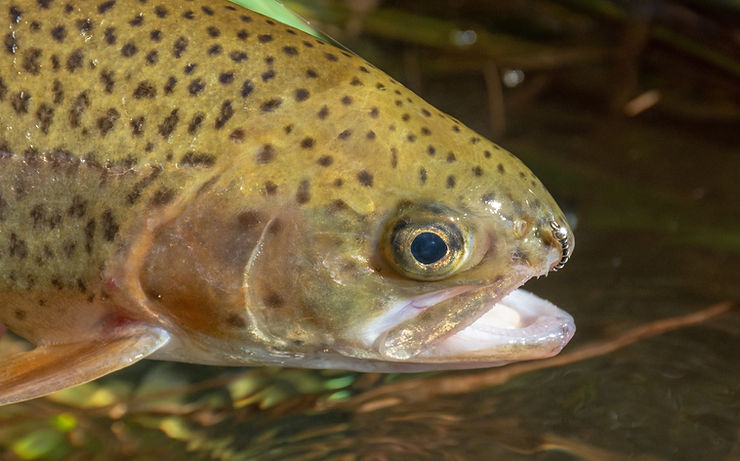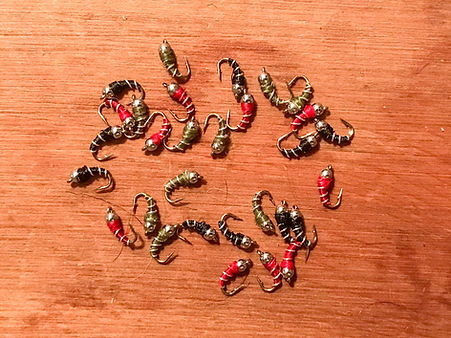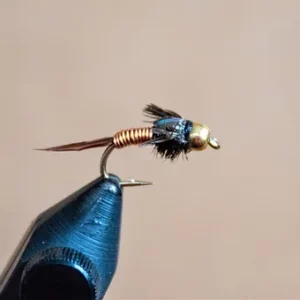Small but Mighty: Fishing the Zebra Midge

Game. Set. Match.
But I must admit, the benefit of these new spectacles is that I can see better close up to tie and fish the Zebra Midge. Thanks, doc!
Zebra Beginnings
The Zebra Midge first made its appearance around 1996, and I can’t help but think of it as a variation of its forerunner, the Ice Cream Cone, which gets its name from using a white bead head rather than a silver or gold bead. That fly was developed by Kelly Davidson in 1992 for fishing many of the lakes in British Columbia, Canada. Although there are a few subtle differences between the patterns, both utilize small, scud or curved-shank hooks, and are meant to imitate midge pupa.
The Zebra Midge is constructed of a tapered thread body with wraps of thin wire over top for ribbing. After the wire is secured near the bead, wrap a few extra turns of thread just behind the bead to create a collar, then tie it off and you’re done.
I prefer a silver bead for my Zebra Midges, but copper and gold both work well. Like anything else, it all comes down to what you’re confident using. The same goes for body color. The most common colors are black, olive, and red, but recently I’ve seen some folks having success with purple.
I tie my Zebra Midges on size 16-22 hooks, but size 18 and size 20 are what I use most. Also, I typically use a bead that is slightly over-sized for the hook. For instance, a 3/32 bead on a size 18 hook and a 5/64 bead on a size 20 hook. Combined with the slim profile of the thread body, this larger bead helps the Zebra Midge sink fast and provides a nice little lifelike contrast for the fly. You can use either brass or tungsten beads, too, but I’ve found that the more expensive tungsten isn’t really necessary.
Are You Enjoying Reading About The Zebra Midge?
Stay up to date with the Dark Skies Fly Fishing monthly newsletter for free and receive the latest posts in fly fishing news, tricks, tips, and techniques, stream reports, as well as updates on new flies added to the Online Store and exclusive discounts!
Sign Up NowWhen and How to Fish Zebras
There’s no wrong time to fish a Zebra Midge, although they arguably perform best from fall through early spring. But truth is, rivers and streams are loaded with tiny insects, and Zebra Midges could represent just about any of them. Last summer, I had an excellent day on Neshannock Creek in early summer, and when I talked to one of the regulars who fish it often, he was amazed that I’d caught all my fish on a size 20 Zebra Midge. He didn’t know what insect would be in the creek that a Zebra might imitate that time of year.

Many fly fishers overthink the process of fly selection. There are times when matching the hatch is crucial, particularly if you fish the tailwaters out west where the Zebra Midge was born. And, of course, Pennsylvania’s spring creek trout are known to be picky, too. But on most freestone streams, a simple attractor-type pattern with a little flash can produce as often as anything.
When fishing any type of midge – or any nymph smaller than a size 16, for that matter – I find that longer leaders and tippets have great value. A 9-foot leader with a 2-3-foot tippet tied to the end is a great starting point for nymphing with these diminutive flies. The tippet should be at least as small as 6x. You’ll have difficulty getting the end of the line through the eye of the hook with tippet much larger than that, but you’ll also lose a lot of fly movement, and therefore effectiveness. The lighter the tippet, the more action the fly will have and the more fish you’ll catch.
I carry a spool of 7x tippet on me especially for fishing Zebra Midges. Generally, 7x tippet equates to 2-pound-test, which can feel even lighter once you’re hooked into a good-sized trout in swift water.
Sometimes just setting the hook can present a challenge, and I’ve certainly broken off my share of fish on the strike. The best way to combat this is to use a medium-action rod and a longer tippet, 3-4 feet in length. The longer tippet provides a better buffer, meaning more stretch and forgiveness on the hook set, and you’ll have fewer break offs.
If I’m using only a Zebra Midge, I’ll sometimes crimp a tiny split shot 6-8 inches above the fly. Trout taking midges are often subtle. The split shot actually helps anchor the leader so that you have more direct contact with your fly. Otherwise, a size 20 or 22 is so light and bounces so much in the current that your leader gets frequent slack. Even with an indicator, some strikes are barely noticeable, and fish can shake off before you even realize you had a hit.
In my opinion, the best way to fish a Zebra Midge on streams and creeks is as a dropper behind a larger, flashier pattern. I do really well trailing it behind a Copper John, Prince Nymph, or even a much bigger stonefly. Trout are attracted to the larger pattern, but will then usually take the smaller trailing fly.
Don’t take the size of a Zebra Midge for granted. These little babies work. Even if you need new glasses just to tie one on.


